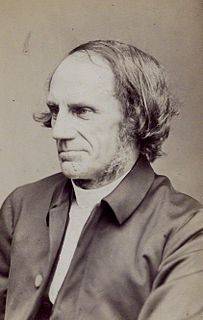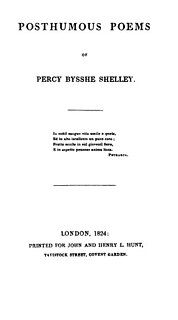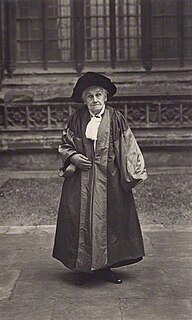An ode is a type of lyrical stanza. It is an elaborately structured poem praising or glorifying an event or individual, describing nature intellectually as well as emotionally. A classic ode is structured in three major parts: the strophe, the antistrophe, and the epode. Different forms such as the homostrophic ode and the irregular ode also enter.

William Wordsworth was an English Romantic poet who, with Samuel Taylor Coleridge, helped to launch the Romantic Age in English literature with their joint publication Lyrical Ballads (1798).

In Greek mythology, Salmacis was an atypical naiad who rejected the ways of the virginal Greek goddess Artemis in favor of vanity and idleness.
In Greek mythology, the Crinaeae were a type of Naiad nymphs associated with fountains or wells.
In Greek mythology, Pirene or Peirene, a nymph, was either the daughter of the river god Asopus, Laconian king Oebalus, or the river god Achelous, depending on different sources. By Poseidon she became the mother of Lecheas and Cenchrias. When Cenchrias was unintentionally killed by Artemis, Pirene's grief was so profound that she became nothing but tears and turned into the fountain outside the gates of Corinth. The Corinthians had a small sanctuary dedicated to Pirene by the fountain where honey-cakes were offered to her to during the dry months of early summer.

Christopher Wordsworth was an English bishop in the Anglican Church and man of letters.

A fountain is a piece of architecture which pours water into a basin or jets it into the air to supply drinking water and/or for a decorative or dramatic effect.

"I Wandered Lonely as a Cloud" is a lyric poem by William Wordsworth. It is Wordsworth's best-known work.

Lyrical Ballads, with a Few Other Poems is a collection of poems by William Wordsworth and Samuel Taylor Coleridge, first published in 1798 and generally considered to have marked the beginning of the English Romantic movement in literature. The immediate effect on critics was modest, but it became and remains a landmark, changing the course of English literature and poetry.

"Love's Philosophy" is a poem by Percy Bysshe Shelley published in 1819.
The Lake Poets were a group of English poets who all lived in the Lake District of England, United Kingdom, in the first half of the nineteenth century. As a group, they followed no single "school" of thought or literary practice then known. They were named, only to be uniformly disparaged, by the Edinburgh Review. They are considered part of the Romantic Movement.

In English, the word laureate has come to signify eminence or association with literary awards or military glory. It is also used for winners of the Nobel Prize, Gandhi Peace Award and the Student Peace Prize.

An abolla was a cloak-like garment worn by ancient Greeks and Romans. Nonius Marcellus quotes a passage of Varro to show that it was a garment worn by soldiers, and thus opposed to the toga.

Dame Elizabeth Wordsworth (1840–1932) was founding Principal of Lady Margaret Hall, Oxford and she funded and founded St Hugh's College. She was also an author, sometimes writing under the name Grant Lloyd. She was the great-niece of the poet William Wordsworth.

The Fountain of Arethusa is a natural fountain on the island of Ortygia in the historical centre of the city of Syracuse in Sicily. According to Greek mythology, the fresh water fountain is the place where the nymph Arethusa, the patron figure of ancient Syracuse, returned to earth's surface after escaping from her undersea home in Arcadia.
William Wordsworth was an English Romantic poet who, with Samuel Taylor Coleridge, helped launch the Romantic Age in English literature with their 1798 joint publication, Lyrical Ballads. His early years were dominated by his experience of the countryside around the Lake District and the English moors. Dorothy Wordsworth, his sister, served as his early companion until their mother's death and their separation when he was sent to school.
The "Matthew" poems are a series of poems, composed by the English Romantic poet William Wordsworth, that describe the character Matthew in Wordsworth's poetry.

"I travelled among unknown men" is a love poem completed in April 1801 by the English poet William Wordsworth and originally intended for the Lyrical Ballads anthology, but it was first published in Poems, in Two Volumes in 1807. The third poem of Wordsworth's "Lucy series", "I travelled..." was composed after the poet had spent time living in Germany in 1798. Due to acute homesickness, the lyrics promise that once returned to England, he will never live abroad again. The poet states he now loves England "more and more". Wordsworth realizes that he did not know how much he loved England until he lived abroad and uses this insight as an analogy to understand his unrequited feelings for his beloved, Lucy.

The Shaftesbury Memorial Fountain, popularly but incorrectly known as "Eros", is a fountain surmounted by a winged statue of Anteros, located at the southeastern side of Piccadilly Circus in London, England. Moved after World War II from its original position in the centre of the circus, it was erected in 1892–93 to commemorate the philanthropic works of Anthony Ashley Cooper, 7th Earl of Shaftesbury, the Victorian politician and philanthropist, and his achievement in replacing child labour with school education. The fountain overlooks the south-west end of Shaftesbury Avenue, also named for the Earl.

Farewell to Orpheus is an outdoor 1968–1973 bronze sculpture and fountain by Frederic Littman, installed at the Portland State University campus in Portland, Oregon, United States.













